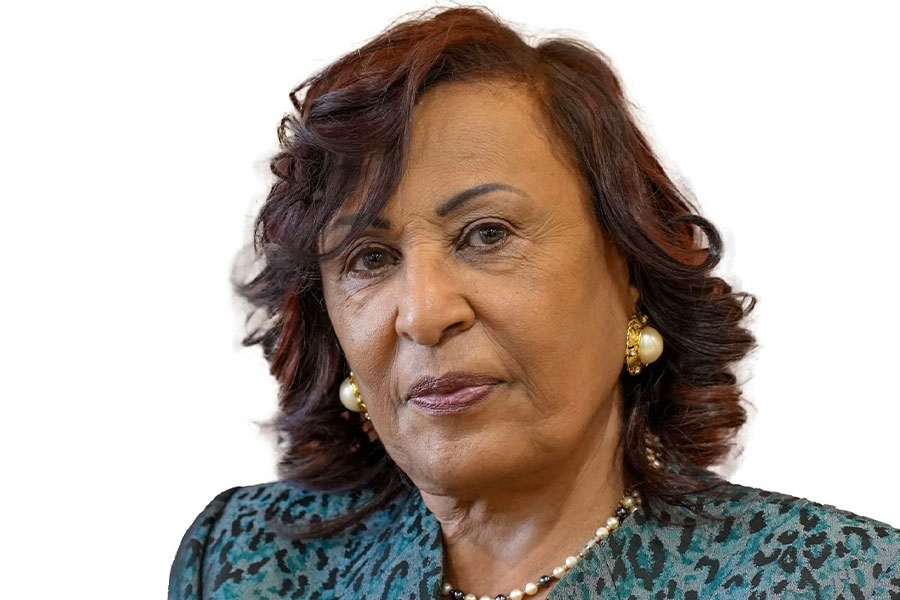
Berhan Bank has staged an impressive turnaround, closing the fiscal year 2023/24 with a sharp increase in profits that vindicated the effectiveness of its new management's strategic decisions. The Bank posted a net profit of 1.19 billion Br, a 134.3pc jump from the previous year, marking a recovery after a period of shareholders’ apprehensions and internal upheaval.
The resurgence comes after a challenging start to the year, marked by the resignation of its former President, Girum Tsegaye, over disagreements with the Board of Directors. With five months left in the fiscal year, the Board, chaired by Eligo Legesse, reinstated former Vice President Ermias Tefera as president, a move approved by the National Bank of Ethiopia (NBE).
Ermias focused on making Berhan profitable and improving its return on equity, which had been in decline.
"We implemented a turnaround strategy, boosting profits and reducing non-performing loans," Eligo told shareholders who met at the Millennium Hall, on Africa Avenue (Bole Road), in mid-October.
The strategy paid off, with earnings per share (EPS) rising to 350.33 Br, surpassing the previous year's 15.6pc and exceeding the industry average of 31.6pc.
The London-based financial analyst Abdulmenan Mohammed (PhD) credited management's strategic maneuvers with the growth.
"Such a leap testifies to Berhan's management focus and determination," he told Fortune.
The profit surge was driven by increased revenues from financial and non-financial intermediation activities and a noteworthy reduction in provisions for loans and asset impairments. This was to be a defining factor, shifting from an expense of 311.15 million Br to an income of 66.92 million Br.
"It reflects prudent risk management," said Abdulmenan.
The change boosted profitability and improved the Bank's return on assets (ROA) to 3.28pc from 1.34pc in June 2023.
Total income rose by 27.3pc to 6.5 billion Br, while interest income from loans, advances, and Central Bank bonds climbed 16.4pc to 5.11 billion Br. Fees and commissions saw a substantial rise, with net revenues surging 73.9pc to 756.72 million Br. Other operating income nearly doubled to 438.26 million Br.
Operating expenses, too, rose substantially by 11pc to five billion Birr. Interest expenses grew by 12.5pc to 1.8 billion Br. Wages and benefits shot up 28.7pc to 2.08 billion Br., and combined with administrative expenses, rose from 57.7pc to 62.7pc of total costs, signalling investments in workforce expansion and branch development.
Analysts caution that such increases could impact profitability if not matched by revenue growth. Abdulmenan cautioned that wage costs have surpassed interest expenses, raising questions about expenditure management.
"Balancing operational expansion with revenue growth will be crucial for maintaining profitability," he said.
Ermias concurred that the expenses were part of a deliberate strategy. He acknowledged that the Bank's biggest expense should be interest-related but disclosed that hiring non-clerical staff full-time instead of outsourcing contributed to higher costs, including benefits.
"It's company policy and part of our corporate social responsibility," he told Fortune.
Although Berhan Bank saw costs climb, executives followed a cost-containment strategy. The asset growth appeared somewhat restrained, with total assets inching up by only 2.2pc to 46.02 billion Br. During the fiscal year, outstanding loans and advances grew by a modest 6.8pc, hitting 29.2 billion Br, well below the lending cap established by regulatory authorities.
Berhan Bank's capital base strengthened, with paid-up capital growing by 2.9pc to 3.45 billion Br, contributing to the rise in EPS. The Bank maintained non-distributable reserves of 4.62 billion Br and a capital adequacy ratio of 15.8pc, nearly double the regulatory minimum.
Its capital-to-asset ratio increased from 11.16pc to 13.5pc, conforming with the industry average. The bolstered capitalisation improved the Bank's resilience against economic shocks and met regulatory capital adequacy requirements, positioning it favourably for further growth.
Incorporated in 2009 with 97 million Br in paid-up capital raised from 12,000 shareholders, Berhan Bank has grown over the years. The equity base has expanded to 18,000, including shareholders like Yared Sisay, who bought shares for his children to secure a long-term asset. While he observed that Berhan Bank had been lagging behind its peers, he sees recent improvements in management and cost optimisation as promising.
"They’ve a lot of work to do," he told Fortune. "But I'm happy now."
Yared urged the Bank’s executives to focus on building an asset portfolio, including constructing a headquarters on recently acquired land. He attributed the streamlined annual report to progress and a move away from unnecessary expenditures.
However, its asset-to-equity ratio declined from 8.96 to 7.41, revealing a strategic move towards reduced leverage and improved equity levels. It surpasses the industry's average leverage ratio of 7.8 times. Industry analysts attribute the drop to the executives' focus on financial stability, providing a stronger equity buffer against potential losses.
The Bank’s net profit margin on total assets soared from 1.13pc to 2.58pc, marking a 128pc increase. This contrasted well with the private banking industry’s average return on average assets (RoAA) of 2.6pc between 2013 and 2022, which had dipped to 2.4pc in 2022.
Berhan Bank's profitability growth revealed effective asset utilisation and operational efficiency, given the industry's recent focus on income from foreign exchange operations over asset-heavy lending.
Nonetheless, its net interest income as a share of total income declined slightly from 54.31pc to 50.77pc, unveiling a diversification of income streams and reduced reliance on traditional interest income. The industry has seen an increasing dependence on interest income, accounting for 65pc to 73pc of total income, signalling a continued focus on lending as the primary revenue driver.
Loan growth at Berhan was 6.79pc, aligning with the executives' strategic focus on credit expansion, though it lags behind the industry's 37.2pc increase in 2022. Deposit mobilisation rose by 9.09pc, unveiling strong customer confidence but again falling short of the industry's average annual increase of 28.9pc. Despite this, Berhan Bank's deposit per branch reached 96.2 million Br, surpassing the industry's average of 79.8 million Br, indicating strong branch-level performance.
The Bank expanded its network with 17 new branches, bringing the total to 383.
Berhan Bank's profit per employee nearly doubled, rising from 91,959 Br to 197,903 Br. The productivity improvement outpaces the industry's average of 76,000 Br, demonstrating effective workforce management and operational efficiency.
One notable branch is the Megenagna location at Marathon Mall, managed by Habtamu Dita. The branch caters to high-net-worth customers, such as pharmaceutical manufacturers, and benefits from policies that provide domestic manufacturers with up to 55pc of foreign currency payments for inputs.
"We've also focused on customer retention," Habtamu told Fortune.
Promoted to a cluster manager, he noted dramatic improvements in communications between branch offices and the head office, enhancing client service efficiency.
However, Berhan Bank's year-on-year growth presented a mixed yet optimistic picture.
Total assets grew modestly by 2.17pc to 46.02 billion Br, a cautious expansion compared to the industry's substantial annual growth rate of 20pc to 25pc. However, the Bank's profit before tax surged by 149.12pc, a sharp divergence from the industry's steady but less dramatic profit trajectory.
The substantial increase is attributed to both revenue growth and stringent cost containment measures.
The loan-to-asset ratio increased from 60.71pc to 63.45pc, approaching the industry's average of 66.2pc, signalling a growing emphasis on lending as a primary income source and efficient asset utilisation.
As more deposits require more interest expense, Ermias believes they were modest in deposit mobilisation while focusing on short-term profits.
"It was a deliberate action," he told Fortune. "We focused on quality."
A seasoned banker, Ermias has held several key positions in the industry. He was a chief inspector at Awash Bank and headed the credit division of the state-owned Commercial Bank of Ethiopia (CBE), where he began his career. He also had stints with Enat and Abyssinia banks. With an economics degree from Addis Abeba University and a postgraduate degree in business administration from the International Leadership Institute, Ermias worked as a private consultant before assuming the leadership position at Berhan Bank.
Under his watch, the Bank’s loan-to-deposit ratio slightly decreased from 80.95pc to 79.24pc, improving liquidity and reflecting conservative lending practices, while the industry's ratio stood higher at 83.7pc.
Despite the improvements, Abdulmenan advised that the executives should be concerned about the stagnation in deposits at around 37.4 billion Br from 33.7 billion Br.
"It should seriously concern the executives," Abdulmenan said.
Berhan Bank's investments in government bills and bonds dipped 5.3pc to 3.6 billion Br, representing 7.8pc of its assets. Liquidity improved as cash and bank balances rose by 29.8pc to 4.84 billion Br, pushing the cash-to-assets ratio up to 10.5pc from 8.3pc.
Though Berhan Bank's liquidity increase is promising, analysts recommend careful monitoring given the stagnation in deposits. The Bank's focus on strengthening its capital base, diversifying income, and enhancing operational efficiency has improved its financial health. Its performance last year showed a deliberate and effective response to industry challenges such as high loan-to-deposit ratios and increased provisioning for non-performing loans.
PUBLISHED ON
Nov 09,2024 [ VOL
25 , NO
1280]

Verbatim | May 31,2025

Radar | Oct 05,2025

News Analysis | Aug 30,2025

Addis Fortune | May 04,2024

Radar | Mar 13,2021

Delicate Number | Jun 07,2025

Radar | Nov 03,2024

Radar | Jul 20,2025

Fortune News | Aug 14,2022

Commentaries | May 31,2025

Dec 22 , 2024 . By TIZITA SHEWAFERAW
Charged with transforming colossal state-owned enterprises into modern and competitiv...

Aug 18 , 2024 . By AKSAH ITALO
Although predictable Yonas Zerihun's job in the ride-hailing service is not immune to...

Jul 28 , 2024 . By TIZITA SHEWAFERAW
Unhabitual, perhaps too many, Samuel Gebreyohannes, 38, used to occasionally enjoy a couple of beers at breakfast. However, he recently swit...

Jul 13 , 2024 . By AKSAH ITALO
Investors who rely on tractors, trucks, and field vehicles for commuting, transporting commodities, and f...

Oct 4 , 2025
Eyob Tekalegn (PhD) had been in the Governor's chair for only weeks when, on Septembe...

Sep 27 , 2025
Four years into an experiment with “shock therapy” in education, the national moo...

Sep 20 , 2025
Getachew Reda's return to the national stage was always going to stir attention. Once...

Sep 13 , 2025
At its launch in Nairobi two years ago, the Africa Climate Summit was billed as the f...